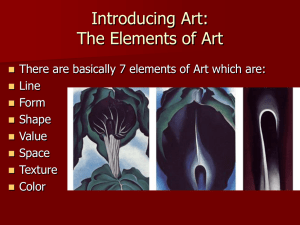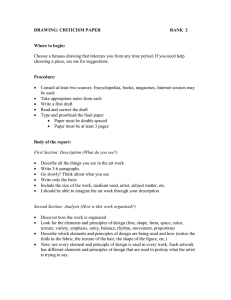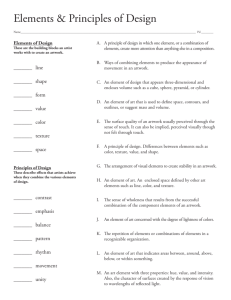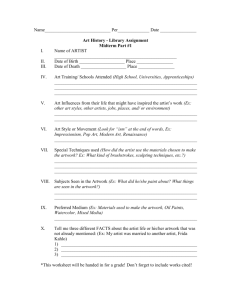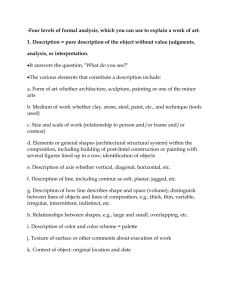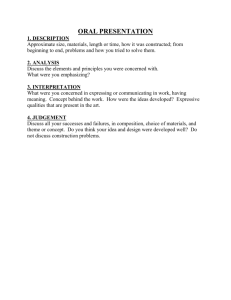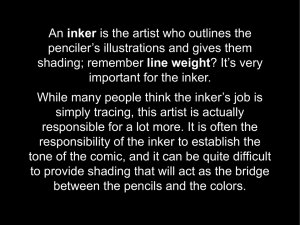Elements and Principles of Art: A Beginner's Guide
advertisement
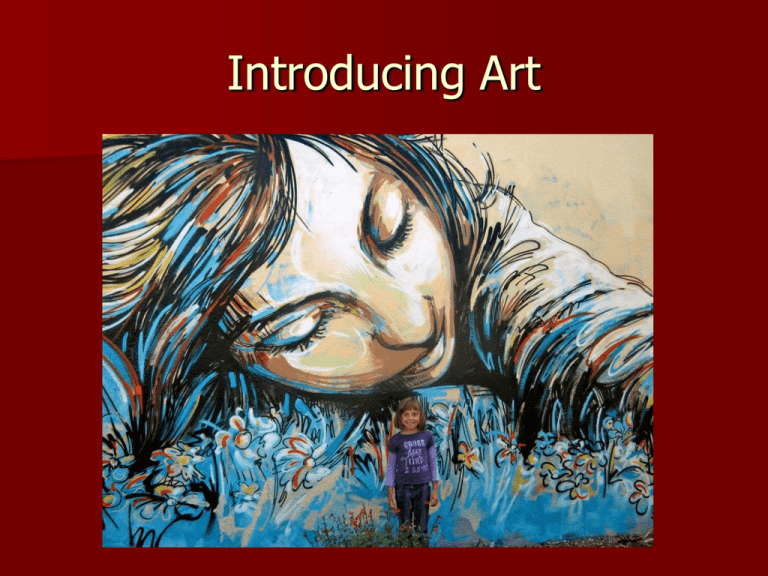
Introducing Art The Elements of Art There are basically 7 elements of Art which are: Line Form Shape Value Space Texture Color Line: Line is the path of a moving point. Lines define the edges of shapes and forms. "Trio" by Steve Magada, 1966, Oil “Jane Avril” by Laurtrec Shape: height + width = shape Shape is an area enclosed by line. It is 2 dimensional and can be geometric or organic. Value is the lightness or darkness of a surface. It is often referred to when shading but value is also important in the study of color Value (Lightness and darkness) Form: Shape Form Height + width + depth = form Forms are 3-Dimensional. They occupy space or give the illusion that they occupy the space. Color is the most expressive element of art and is seen by the way light reflects off a surface. Color Color is the most expressive of the elements and can also be very tricky to use properly, Texture: Texture is the actual surface feel of an area or the simulated appearance of roughness, smoothness or many others. Space: Space is the illusion of objects having depth on the 2-dimensional surface. Linear and aerial perspective are used. Space refers to the distances or areas around, between or within components of a piece. There are two type of space: positive and negative space. The 7 Principles of Art The principles of visual art are the rules, tools and/or guidelines that artists use to organize the elements of art in an artwork Movement Movement shows actions or the path the viewer's eye follows throughout an artwork. Harmony Harmony is when an artists uses similar elements throughout the work, and gives an uncomplicated look to a piece of artwork. Balance Balance is arranging elements so that no one part of a work overpowers, or seems heavier than any other part. Three types of Balance Symmetrical Asymmetrical Radial Pattern Pattern is the repetition of the elements of art. Contrast Contrast refers to the arrangement of opposite elements (light vs. dark colors, large vs. small shapes, etc.) in a piece so as to create visual interest, excitement and drama Emphasis Emphasis occurs any time an element of a piece is given dominance by the artist. In other words, the artist makes part of the work stand out, in order to draw the viewer's eye there first. Variety Variety is the quality or state of having different forms or types, notable use of contrast, emphasis, difference in size and color Why are the elements of art important? Because. The elements of art are important for several reasons. First, and most importantly, a person can't create art without utilizing at least a few of them. (No elements, no art, end of story. And we wouldn't even be talking about any of this, would we?) Secondly, knowing what the elements of art are enables us to (1) describe what an artist has done, (2) analyze what is going on in a particular piece and (3) communicate our thoughts and findings using a common language. Your assignment: -Create a book cover for your artist notes booklet. -You must use at least 5 of the elements and principles of art. (list the ones that you used.) Your Assignment: create a name tag for you locker utilizing the Elements and Principles of art. Your Assignment: create a work of art utilizing five (5) elements of art in a composition. The subject matter, medium, style and technique is your choice, but the reference material and scrap need to be gathered and organized on your own time, not on classroom time. “Puffy Face” by James Christensen

